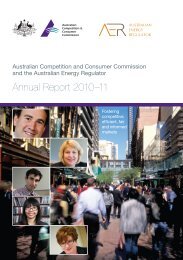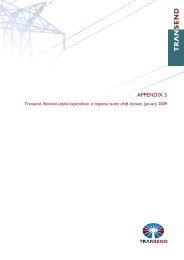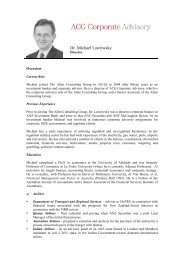Internal consistency of risk free rate and MRP in the CAPM
Internal consistency of risk free rate and MRP in the CAPM
Internal consistency of risk free rate and MRP in the CAPM
Create successful ePaper yourself
Turn your PDF publications into a flip-book with our unique Google optimized e-Paper software.
Reserve Bank assistant governor Guy Debelle said this week <strong>the</strong> dem<strong>and</strong> for<br />
Australian bonds was com<strong>in</strong>g largely from <strong>the</strong> sovereign wealth funds <strong>of</strong> foreign<br />
governments.<br />
Mr Debelle said <strong>the</strong> Reserve estimated that 75 per cent <strong>of</strong> Australian bonds were<br />
owned <strong>of</strong>fshore. He said foreign dem<strong>and</strong> for Australian bonds could be partly<br />
responsible for <strong>the</strong> recent strength <strong>of</strong> <strong>the</strong> Australian dollar.<br />
110. The heightened dem<strong>and</strong> for CGS from foreign <strong>in</strong>vestors appears to have pushed<br />
domestic <strong>in</strong>vestors <strong>in</strong>to state government debt. While Australian <strong>in</strong>vestors only hold<br />
around 25% <strong>of</strong> CGS, <strong>the</strong>y hold around 60% <strong>of</strong> <strong>the</strong> market value <strong>of</strong> state government<br />
debt (up from 53% <strong>in</strong> June 2007). 33<br />
111. This heightened dem<strong>and</strong> from foreigners comes at <strong>the</strong> same time that changes to<br />
bank<strong>in</strong>g regulations are rais<strong>in</strong>g <strong>the</strong> dem<strong>and</strong> for CGS <strong>and</strong> state government debt from<br />
Australian banks. Specifically, under Basel III regulations banks will be required to<br />
hold an <strong>in</strong>creased proportion <strong>of</strong> <strong>the</strong>ir balance sheet <strong>in</strong> high quality liquid assets. The<br />
purpose <strong>of</strong> this regulation is to ensure that banks <strong>in</strong>dividually, <strong>and</strong> <strong>the</strong> bank<strong>in</strong>g system<br />
as a whole, can avoid <strong>the</strong> need to engage <strong>in</strong> ‘fire sales’ <strong>of</strong> illiquid assets <strong>in</strong> <strong>the</strong> event <strong>of</strong><br />
a runs on <strong>the</strong> bank<strong>in</strong>g system (<strong>and</strong> <strong>the</strong>reby avoid<strong>in</strong>g a systemic reduction <strong>in</strong> <strong>the</strong> value<br />
<strong>of</strong> all such assets held <strong>in</strong> <strong>the</strong> bank<strong>in</strong>g system).<br />
112. In describ<strong>in</strong>g <strong>the</strong> implementation <strong>of</strong> Basel III, APRA’s Charles Littrel has stated: 34<br />
First, we <strong>in</strong>tend to ensure that each bank reasonably optimises its use <strong>of</strong><br />
Commonwealth Government Securities <strong>and</strong> semi-government securities, which<br />
are <strong>the</strong> most liquid assets <strong>in</strong> our market. But at <strong>the</strong> same time, hold<strong>in</strong>gs <strong>of</strong> this<br />
stock cannot allow <strong>the</strong> liquidity <strong>in</strong> <strong>the</strong>se markets to be soaked up.<br />
113. The problem for Australia is that <strong>the</strong>re simply are too few CGS <strong>and</strong> state government<br />
debt <strong>in</strong>struments on issue that will allow <strong>the</strong> Basel III <strong>in</strong>duced dem<strong>and</strong> for <strong>the</strong>se assets<br />
to be satisfied (at least without destroy<strong>in</strong>g <strong>the</strong> liquidity <strong>of</strong> <strong>the</strong>se assets). RBA Assistant<br />
Governor Guy Debelle has expla<strong>in</strong>ed <strong>the</strong> magnitude <strong>of</strong> this effect <strong>in</strong> <strong>the</strong> follow<strong>in</strong>g<br />
way. 35<br />
The Basel liquidity st<strong>and</strong>ard requires that banks have access to enough highquality<br />
liquid assets to withst<strong>and</strong> a 30-day stress scenario, <strong>and</strong> specifies <strong>the</strong><br />
characteristics required to be considered an eligible liquid asset.<br />
33 Lancaster <strong>and</strong> Dowl<strong>in</strong>g, The Australian Semi-government Bond Market, RBA bullet<strong>in</strong>, September Quarter 2011, page 53.<br />
34 APRA’s Basel III Implementation rationale <strong>and</strong> impacts, Charles Littrell, Exec. GM, Policy, Research <strong>and</strong> Statistics, APRA,<br />
APRA F<strong>in</strong>isia Workshop, Sydney, 23 November 2011.<br />
35 Guy Debelle, RBA Assistant Governor (F<strong>in</strong>ancial Markets), Speech to <strong>the</strong> APRA Basel III Implementation Workshop 2011<br />
Sydney - 23 November 2011.<br />
Competition Economists Group<br />
www.CEG-AP.COM<br />
30







